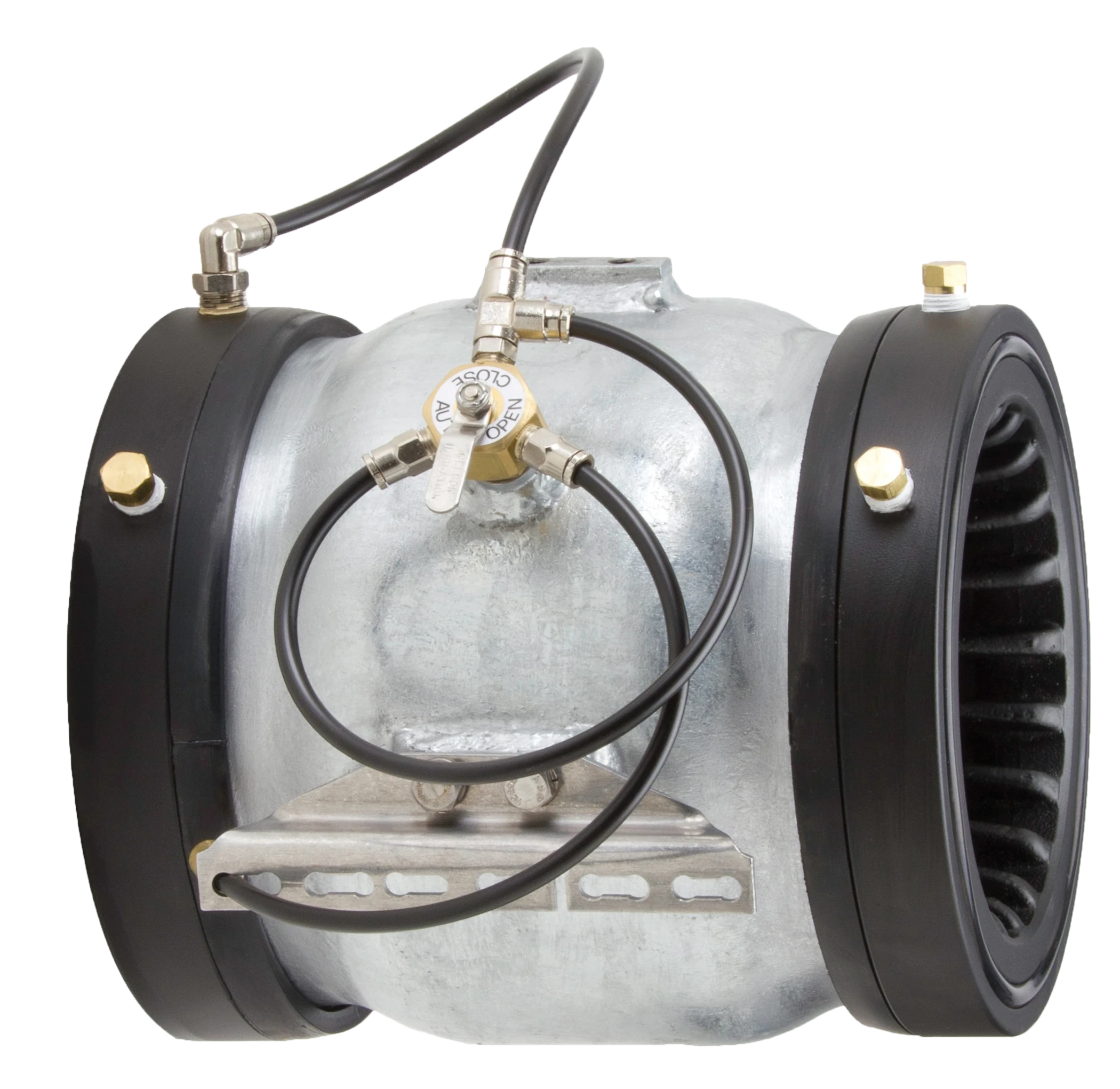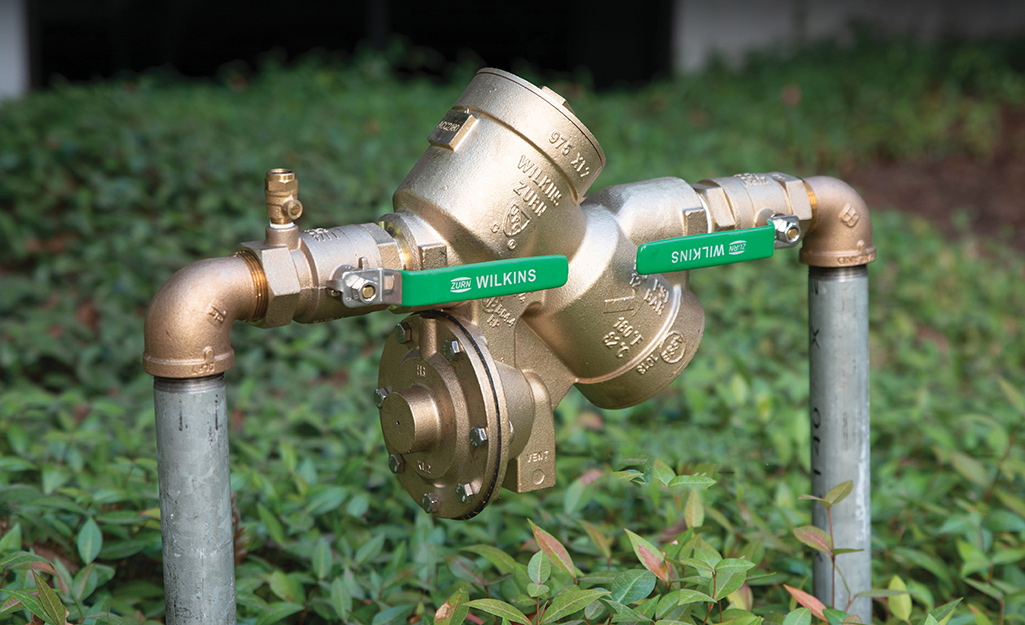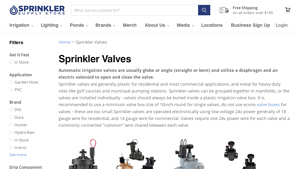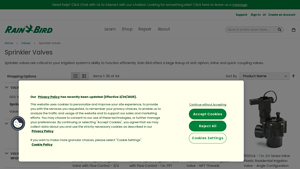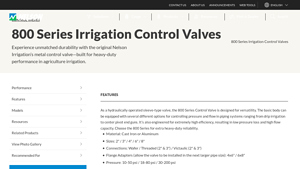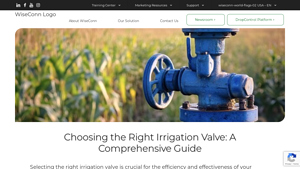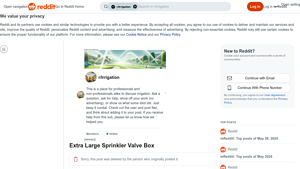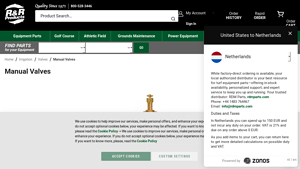Introduction: Navigating the Global Market for large steel irrigation main valve
In the ever-evolving landscape of global agriculture, sourcing large steel irrigation main valves presents a significant challenge for international B2B buyers. With the increasing demand for efficient water management systems, especially in regions like Africa, South America, the Middle East, and Europe, selecting the right valve is critical for ensuring operational efficiency and sustainability. This guide offers a comprehensive examination of large steel irrigation main valves, covering essential aspects such as types, applications, supplier vetting processes, and cost considerations.
Understanding the various types of large steel irrigation valves available, along with their specific applications, is crucial for making informed purchasing decisions. This guide not only highlights the functional features and benefits of these valves but also provides insights into the procurement process, helping buyers navigate the complexities of supplier selection.
By delving into critical factors like performance metrics, regulatory compliance, and long-term value, this resource empowers buyers to identify suppliers that align with their operational needs and budget constraints. Whether you are looking to enhance agricultural productivity in Nigeria or optimize water distribution systems in Vietnam, this guide serves as a valuable tool to facilitate informed decisions in the procurement of large steel irrigation main valves.
Understanding large steel irrigation main valve Types and Variations
| Type Name | Key Distinguishing Features | Primary B2B Applications | Brief Pros & Cons for Buyers |
|---|---|---|---|
| Globe Valve | Spherical shape, allows for throttling, high-pressure rating | Agriculture, municipal water systems | Pros: Precise flow control; Cons: Higher pressure drop. |
| Gate Valve | Simple design, full flow capacity, minimal resistance | Large-scale irrigation, water supply | Pros: Low flow resistance; Cons: Limited throttling ability. |
| Ball Valve | Spherical closure element, quick operation, low torque | Industrial applications, irrigation systems | Pros: Quick shut-off; Cons: More expensive than other types. |
| Check Valve | Prevents backflow, automatic operation | Irrigation systems, drainage applications | Pros: Protects systems from backflow; Cons: Maintenance can be complex. |
| Butterfly Valve | Compact design, quarter-turn operation, lightweight | Large pipelines, agricultural applications | Pros: Space-efficient; Cons: Not suitable for throttling. |
What are the Characteristics and Suitability of Globe Valves in Large Steel Irrigation Systems?
Globe valves are characterized by their spherical body design, which allows for effective throttling and flow regulation. They are particularly suitable for high-pressure applications, making them ideal for municipal water systems and agricultural irrigation where precise control is essential. When considering a globe valve for purchase, B2B buyers should assess the specific pressure ratings and flow capacities to ensure compatibility with their systems.
How Do Gate Valves Compare for Large Scale Irrigation Needs?
Gate valves feature a straightforward design that enables full flow capacity with minimal resistance. This makes them particularly effective in large-scale irrigation systems and water supply applications where flow needs to be maximized. Buyers should evaluate the size and material specifications, as well as the valve’s ability to handle the required pressure levels, to ensure it meets their operational demands.
Why Choose Ball Valves for Industrial Applications?
Ball valves are known for their quick operation and low torque requirements, making them ideal for industrial applications and irrigation systems that require rapid shut-off capabilities. Their spherical closure element provides a tight seal, preventing leaks. B2B buyers should consider the valve’s material and size, as these factors will impact both performance and cost.
What Role Do Check Valves Play in Irrigation Systems?
Check valves are crucial for preventing backflow in irrigation systems and drainage applications. They operate automatically, ensuring that water only flows in one direction, which protects the integrity of the system. When purchasing check valves, buyers should focus on maintenance requirements and the specific design features that suit their operational environment.
How Do Butterfly Valves Enhance Efficiency in Large Pipelines?
Butterfly valves are recognized for their compact design and lightweight construction, allowing for easy installation in large pipelines. They operate with a quarter-turn mechanism, making them efficient for applications where space is a premium, such as in agricultural settings. Buyers should assess the valve’s pressure rating and compatibility with existing systems to ensure optimal performance.
Key Industrial Applications of large steel irrigation main valve
| Industry/Sector | Specific Application of large steel irrigation main valve | Value/Benefit for the Business | Key Sourcing Considerations for this Application |
|---|---|---|---|
| Agriculture | Large-scale irrigation systems for crop production | Ensures efficient water distribution, enhancing crop yield | Durability, pressure ratings, compatibility with existing systems |
| Municipal Water Supply | Water distribution networks for urban areas | Reliable water management and conservation | Compliance with local regulations, maintenance support |
| Golf Course Management | Irrigation systems for landscaping and turf management | Maintains optimal turf health and aesthetics | Flow control features, ease of installation, corrosion resistance |
| Mining Operations | Dust suppression and land reclamation irrigation | Enhances safety and environmental compliance | High pressure tolerance, robust construction, service life |
| Industrial Facilities | Cooling systems and process water management | Improves operational efficiency and reduces downtime | Customization options, size specifications, availability of spare parts |
How is the large steel irrigation main valve utilized in Agriculture?
In agriculture, large steel irrigation main valves are integral to large-scale irrigation systems designed to optimize water usage for crop production. These valves facilitate the regulation and distribution of water across extensive farmland, ensuring that crops receive adequate hydration. By utilizing these valves, farmers can enhance crop yield and minimize water wastage. Buyers in this sector should prioritize valves with high durability and pressure ratings, as well as compatibility with existing irrigation systems to ensure seamless integration.
What role do large steel irrigation main valves play in Municipal Water Supply?
In municipal water supply, large steel irrigation main valves are crucial for managing water distribution networks in urban areas. These valves help maintain consistent water pressure and flow, ensuring that residents and businesses have reliable access to water. The use of these valves can lead to improved water management and conservation efforts. Buyers should consider compliance with local regulations, as well as the availability of maintenance support, to ensure long-term reliability and efficiency in their water supply systems.
How do large steel irrigation main valves benefit Golf Course Management?
For golf course management, large steel irrigation main valves are essential for maintaining irrigation systems that support landscaping and turf management. These valves allow for precise control over water flow, which is vital for keeping the turf healthy and visually appealing. The efficient use of water not only enhances the aesthetics of the course but also contributes to sustainable water management practices. When sourcing these valves, buyers should look for features such as flow control capabilities, ease of installation, and resistance to corrosion to ensure longevity and performance.
What is the significance of large steel irrigation main valves in Mining Operations?
In mining operations, large steel irrigation main valves are employed for dust suppression and land reclamation efforts. These valves help manage water flow to control dust levels, thereby enhancing safety for workers and complying with environmental regulations. Additionally, they play a role in rehabilitating land post-extraction. Buyers in this sector need to focus on valves with high pressure tolerance and robust construction to withstand the demanding conditions typical of mining environments.
How do large steel irrigation main valves support Industrial Facilities?
Industrial facilities utilize large steel irrigation main valves in cooling systems and for process water management. These valves help regulate water flow, improving operational efficiency and reducing downtime in various industrial processes. By ensuring a steady supply of water, they contribute to smoother operations and enhanced productivity. Buyers should consider customization options, size specifications, and the availability of spare parts to meet the specific needs of their facilities, ensuring that their operations remain uninterrupted.
3 Common User Pain Points for ‘large steel irrigation main valve’ & Their Solutions
Scenario 1: High Corrosion Rates in Harsh Environments
The Problem: B2B buyers in regions with extreme weather conditions, such as high humidity or salinity, often face significant challenges with the corrosion of large steel irrigation main valves. Over time, this corrosion can lead to leaks, reduced efficiency, and ultimately, complete failure of the valves. This not only disrupts irrigation systems but also incurs high replacement costs and operational downtime, affecting productivity and profitability.
The Solution: To mitigate corrosion issues, it is crucial to select valves that are specifically designed for harsh environments. Buyers should consider sourcing large steel irrigation main valves that feature protective coatings, such as epoxy or polyurethane, which can significantly enhance the valve’s durability. Additionally, stainless steel or galvanized steel options may be more suitable in corrosive settings. Implementing regular maintenance checks, including visual inspections and the use of corrosion inhibitors, can help extend the lifespan of these valves. Establishing a partnership with a reputable supplier who understands local conditions and can provide tailored solutions is also essential for long-term success.
Scenario 2: Inconsistent Water Flow and Pressure Issues
The Problem: In agricultural settings, inconsistent water flow and pressure can lead to uneven irrigation, which negatively impacts crop yield. B2B buyers often encounter this issue when large steel irrigation main valves are improperly sized or not calibrated correctly for their specific applications. The result is water wastage, increased operational costs, and frustrated end-users who depend on reliable irrigation systems.
The Solution: To address flow and pressure inconsistencies, buyers must accurately calculate the required specifications before purchasing large steel irrigation main valves. This involves understanding the entire irrigation system, including pipe sizes, total dynamic head, and the specific flow rates needed for different crops. Utilizing flow meters and pressure gauges during installation can help monitor performance in real-time. Additionally, working with engineers or irrigation specialists to design a system that includes appropriate valves with flow control features will ensure optimal operation. Regular testing and recalibration of the system can further enhance performance, leading to better resource management and improved crop outcomes.
Scenario 3: Difficulty in Valve Operation and Maintenance
The Problem: Many B2B buyers face operational challenges due to the complexity of manually operating large steel irrigation main valves, particularly in larger agricultural setups. These difficulties can lead to inefficient irrigation practices, increased labor costs, and the potential for human error during operation. Additionally, maintenance can become cumbersome without proper access or clear operational guidelines.
The Solution: Implementing automated control systems can greatly simplify the operation of large steel irrigation main valves. Buyers should explore options such as electric actuators or solenoid-operated valves that allow for remote control and automation of the irrigation process. This not only enhances efficiency but also reduces the likelihood of human error. Furthermore, investing in training for staff on proper operation and maintenance procedures is vital. Creating a user-friendly maintenance schedule and ensuring easy access to the valves will facilitate regular upkeep. Providing clear documentation and resources about valve operation can empower users, leading to more effective irrigation management.
Strategic Material Selection Guide for large steel irrigation main valve
What Are the Key Materials for Large Steel Irrigation Main Valves?
When selecting materials for large steel irrigation main valves, several options stand out based on their properties, advantages, and limitations. Understanding these materials can help international B2B buyers make informed decisions tailored to their specific application needs.
How Does Carbon Steel Perform in Large Steel Irrigation Main Valves?
Carbon steel is a widely used material for large steel irrigation main valves due to its excellent strength and durability. It typically has a high pressure rating, making it suitable for various irrigation applications. However, carbon steel is susceptible to corrosion, particularly in environments with high moisture or aggressive chemicals.
Pros: Carbon steel valves are cost-effective and can handle high pressures, making them ideal for heavy-duty applications. They are also relatively easy to manufacture and can be produced in various sizes.
Cons: The primary drawback is their vulnerability to corrosion, which can lead to premature failure if not properly coated or maintained. This can be a significant concern in regions with high humidity or saline conditions.
Impact on Application: Carbon steel valves are compatible with water and various agricultural chemicals but may require protective coatings to enhance their lifespan.
Considerations for International Buyers: Buyers from regions like Africa and South America should ensure compliance with local standards such as ASTM or ISO, particularly regarding corrosion resistance treatments.
What Role Does Stainless Steel Play in Large Steel Irrigation Main Valves?
Stainless steel is another popular material choice for large steel irrigation main valves, known for its superior corrosion resistance and longevity. It can withstand a wide range of temperatures and pressures, making it versatile for many applications.
Pros: The key advantage of stainless steel is its resistance to rust and corrosion, which reduces maintenance costs over time. It also offers a clean appearance and is suitable for applications involving potable water.
Cons: The primary disadvantage is its higher cost compared to carbon steel, which may deter budget-conscious buyers. Additionally, manufacturing stainless steel valves can be more complex, requiring specialized equipment.
Impact on Application: Stainless steel valves are ideal for environments where corrosion is a significant concern, such as coastal areas or regions with high salinity in the water.
Considerations for International Buyers: Buyers in the Middle East and Europe should verify compliance with standards such as DIN or JIS, ensuring that the material grades meet the necessary specifications for durability and safety.
How Does Ductile Iron Compare for Large Steel Irrigation Main Valves?
Ductile iron is increasingly favored for large steel irrigation main valves due to its excellent mechanical properties and resistance to impact and fatigue. It can handle high pressures and is often used in municipal applications.
Pros: Ductile iron valves are robust and can withstand harsh conditions, making them suitable for heavy-duty applications. They are also easier to cast into complex shapes compared to steel.
Cons: The main limitation of ductile iron is its weight, which can complicate installation and transportation. Additionally, it is less corrosion-resistant than stainless steel, requiring protective coatings.
Impact on Application: Ductile iron valves are compatible with various irrigation media but may necessitate protective measures in corrosive environments.
Considerations for International Buyers: Buyers should ensure compliance with local standards for ductile iron, particularly in regions like Nigeria, where infrastructure durability is critical.
Summary Table of Material Selection for Large Steel Irrigation Main Valves
| Material | Typical Use Case for large steel irrigation main valve | Key Advantage | Key Disadvantage/Limitation | Relative Cost (Low/Med/High) |
|---|---|---|---|---|
| Carbon Steel | Heavy-duty irrigation systems | Cost-effective and high strength | Susceptible to corrosion | Low |
| Stainless Steel | Potable water applications | Superior corrosion resistance | Higher cost and manufacturing complexity | High |
| Ductile Iron | Municipal irrigation applications | Robust and impact-resistant | Heavy and less corrosion-resistant | Medium |
This analysis of materials for large steel irrigation main valves provides essential insights for B2B buyers, enabling them to select the most appropriate options for their specific needs and regional conditions.
In-depth Look: Manufacturing Processes and Quality Assurance for large steel irrigation main valve
What Are the Key Manufacturing Processes for Large Steel Irrigation Main Valves?
Manufacturing large steel irrigation main valves involves several critical stages, each designed to ensure the final product meets stringent quality and performance standards. The primary stages include material preparation, forming, assembly, and finishing.
How Is Material Prepared for Steel Irrigation Valves?
The manufacturing process begins with the selection and preparation of high-quality steel, typically carbon or stainless steel, chosen for its durability and resistance to corrosion. This involves cutting the steel into appropriate sizes and shapes, followed by processes such as heat treatment to enhance its mechanical properties. Steel is often sourced from suppliers who adhere to recognized international standards, ensuring that the materials meet the necessary specifications for strength and longevity.
What Forming Techniques Are Used in Valve Manufacturing?
Once the materials are prepared, the next stage is forming. This can involve several techniques, including forging, casting, and machining. Forging is commonly used for producing high-strength components, where steel is heated and shaped under pressure. Casting may be employed for more complex shapes, where molten steel is poured into molds. Machining processes, such as CNC turning and milling, are used to achieve precise dimensions and surface finishes, essential for proper sealing and functionality of the valve.
How Are Large Steel Irrigation Valves Assembled?
The assembly stage involves integrating various components, including the valve body, diaphragm, and actuator mechanisms. This process requires skilled technicians who ensure that each part fits correctly and operates smoothly. Sealing materials, often made from elastomers, are installed to prevent leaks and ensure the valve maintains its integrity under pressure. Quality control checkpoints during assembly verify that tolerances and specifications are met before moving on to the finishing stage.
What Finishing Processes Enhance Valve Performance?
Finishing processes are vital for enhancing the performance and longevity of the valves. This typically includes surface treatments such as galvanizing or powder coating to improve corrosion resistance. The finishing stage may also involve pressure testing to ensure that the valve can withstand operational conditions without failure. These tests are crucial, particularly in regions with extreme weather conditions, such as Africa and South America, where irrigation systems must endure significant stress.
What Quality Assurance Measures Are Essential for Steel Irrigation Valves?
Quality assurance (QA) is a cornerstone of the manufacturing process for large steel irrigation main valves. It ensures that every valve produced meets international standards and customer expectations.
Which International Standards Should Be Considered?
For B2B buyers, familiarity with international standards such as ISO 9001 is essential. This standard outlines the requirements for a quality management system, ensuring that manufacturers consistently meet customer and regulatory requirements. Additionally, industry-specific certifications such as CE (European Conformity) and API (American Petroleum Institute) are critical, particularly for valves used in critical applications where safety and reliability are paramount.
How Are QC Checkpoints Implemented in the Manufacturing Process?
Quality control involves several checkpoints throughout the manufacturing process, including:
- Incoming Quality Control (IQC): This step verifies the quality of raw materials before they enter production. Suppliers must provide certification of compliance with standards.
- In-Process Quality Control (IPQC): Inspections during the manufacturing process ensure that each stage meets specified standards. This may include dimensional checks and functional tests.
- Final Quality Control (FQC): Before shipping, valves undergo rigorous testing, including pressure tests and leak tests, to confirm their performance under operational conditions.
What Testing Methods Are Commonly Used for Valves?
Common testing methods for large steel irrigation main valves include hydrostatic testing, where the valve is subjected to water pressure to check for leaks, and functional testing to ensure that the valve operates correctly. Non-destructive testing (NDT) methods, such as ultrasonic testing or magnetic particle inspection, may also be employed to detect internal flaws without damaging the product.
How Can B2B Buyers Verify Supplier Quality Control?
For international buyers, particularly from regions like Africa, South America, the Middle East, and Europe, verifying a supplier’s quality control processes is crucial. Here are several strategies to ensure product reliability:
What Auditing Processes Should Be Considered?
Conducting supplier audits is one of the most effective ways to assess quality control practices. Buyers should request to review the supplier’s quality management system documentation and previous audit reports. Regular audits can help ensure compliance with international standards and identify areas for improvement.
How Important Are Certification and Documentation?
Requesting certifications such as ISO 9001, CE, or API is essential for verifying a supplier’s commitment to quality. Documentation should include test reports, material certifications, and inspection records that demonstrate compliance with standards throughout the manufacturing process.
What Role Do Third-Party Inspections Play?
Engaging third-party inspection agencies can provide an unbiased assessment of the manufacturing process. These agencies can conduct inspections at various stages, ensuring that the supplier adheres to agreed-upon specifications and standards.
What Nuances Should International Buyers Be Aware Of?
B2B buyers from different regions must be aware of the nuances in quality control and compliance requirements. Understanding regional regulations and standards can help avoid costly misunderstandings. For instance, European buyers may have stricter CE marking requirements than those in South America.
Additionally, cultural differences in business practices can affect communication and expectations regarding quality assurance. Buyers should ensure clear and consistent communication with suppliers regarding quality expectations and compliance standards.
In summary, understanding the manufacturing processes and quality assurance measures for large steel irrigation main valves is crucial for international B2B buyers. By focusing on material preparation, forming techniques, assembly, and finishing, along with rigorous quality control practices, buyers can ensure they procure reliable and durable products that meet their operational needs.
Practical Sourcing Guide: A Step-by-Step Checklist for ‘large steel irrigation main valve’
Introduction
Navigating the procurement process for large steel irrigation main valves can be complex, especially for international B2B buyers. This checklist serves as a practical guide to ensure you make informed decisions, reduce risks, and optimize your investment. From defining specifications to verifying supplier credentials, each step is crucial to achieving operational efficiency and durability in your irrigation systems.
1. Define Your Technical Specifications
Before initiating the sourcing process, clarify the technical requirements for the valves you need. Consider factors such as pressure ratings, flow rates, and the specific materials required for durability against environmental conditions. This step is vital to ensure compatibility with existing systems and to meet the operational demands of your irrigation projects.
2. Research Potential Suppliers
Invest time in researching suppliers that specialize in large steel irrigation main valves. Look for manufacturers with a proven track record in your target regions—Africa, South America, the Middle East, and Europe. This will help you identify suppliers who understand local regulations and market needs, which can be pivotal for successful procurement.
3. Evaluate Supplier Certifications
✅ Verify Supplier Certifications
Check for relevant industry certifications such as ISO 9001 or other quality management standards. Certifications can indicate a supplier’s commitment to quality and adherence to safety standards. Also, confirm if they comply with any local regulations that may apply in your region, ensuring that the products meet necessary legal requirements.
4. Request Samples or Prototypes
Before making a bulk order, request samples or prototypes of the valves. This allows you to assess the quality, craftsmanship, and suitability of the valves for your specific applications. Evaluate the samples for performance under pressure, ease of installation, and overall durability to ensure they meet your operational standards.
5. Assess Pricing and Payment Terms
Compare pricing across different suppliers while considering the total cost of ownership, not just the initial purchase price. Look for suppliers who offer flexible payment terms that align with your cash flow needs. This step is essential to ensure that you are getting a competitive deal without compromising on quality.
6. Check References and Customer Feedback
Request references from previous customers to gain insights into the supplier’s reliability and service quality. Look for feedback regarding their responsiveness, after-sales support, and how they handle warranty claims. This information can provide valuable context to your purchasing decision and help mitigate future risks.
7. Finalize Logistics and Delivery Terms
Once you select a supplier, clarify the logistics involved in the delivery of the valves. Discuss shipping options, lead times, and any associated costs. Understanding these details upfront can prevent delays and ensure that your procurement aligns with project timelines.
By following these steps, you can streamline the sourcing process for large steel irrigation main valves, ultimately leading to better decision-making and successful project outcomes.
Comprehensive Cost and Pricing Analysis for large steel irrigation main valve Sourcing
When sourcing large steel irrigation main valves, understanding the cost structure and pricing dynamics is crucial for international B2B buyers. This analysis will focus on the various cost components, price influencers, and practical tips for negotiating favorable terms.
What Are the Key Cost Components for Large Steel Irrigation Main Valves?
Materials: The primary material used in large steel irrigation valves is high-grade steel, which offers durability and resistance to corrosion. Prices can fluctuate based on global steel market conditions, quality standards, and any additional coatings or treatments required for specific environmental conditions.
Labor: Labor costs can vary significantly depending on the manufacturing location. In regions with lower labor costs, such as parts of Africa and South America, you may find competitive pricing. However, it’s essential to consider the skill level of the workforce, as experienced labor may lead to higher initial costs but better long-term reliability.
Manufacturing Overhead: This includes the costs associated with factory operation, equipment maintenance, and utility expenses. Suppliers may pass these costs onto buyers, so it’s beneficial to assess potential manufacturers’ operational efficiencies.
Tooling: Customization of valves often requires specialized tooling, which can add to the initial cost. The more complex the valve design, the higher the tooling expenses. Understanding the tooling amortization process is vital for evaluating long-term costs.
Quality Control (QC): Rigorous QC processes ensure that the valves meet international standards and certifications. This can involve additional costs, but investing in quality control can reduce the risk of failures and subsequent replacements.
Logistics: Shipping and handling costs are influenced by the distance from the supplier, mode of transportation, and any tariffs or taxes imposed. Using Incoterms effectively can help in negotiating logistics costs.
Margin: Suppliers will typically include a margin to cover their risks and profit. Understanding the typical margins in your industry can help you gauge whether the pricing is competitive.
What Influences the Pricing of Large Steel Irrigation Main Valves?
Volume and Minimum Order Quantity (MOQ): Pricing often improves with larger orders due to economies of scale. Establishing a relationship with suppliers for bulk purchases can lead to significant savings.
Specifications and Customization: Customized valves that meet specific needs will generally cost more than standard options. Providing clear specifications can help suppliers offer more accurate pricing.
Quality and Certifications: Valves that comply with international quality standards (e.g., ISO certifications) may come at a premium. However, these certifications can also enhance reliability and performance, justifying the higher price.
Supplier Factors: The reputation and reliability of the supplier can affect pricing. Established suppliers may charge more due to their track record, but they often provide better service and product reliability.
Incoterms: Understanding Incoterms can significantly affect the total cost. Terms such as FOB (Free On Board) or CIF (Cost, Insurance, and Freight) can shift responsibilities and costs between buyer and seller, influencing the final price.
What Tips Can Buyers Use to Negotiate Better Prices?
Engage in Early Negotiations: Start discussions early, especially for large orders. This allows for better price negotiation and customization options.
Evaluate Total Cost of Ownership (TCO): Don’t just focus on the purchase price. Consider maintenance, durability, and potential downtime costs to assess the overall value.
Leverage Competition: Obtain quotes from multiple suppliers to create competitive pressure. This can lead to better pricing and terms.
Understand Local Market Dynamics: For buyers in Africa, South America, the Middle East, and Europe, being aware of local economic conditions, tariffs, and trade agreements can provide leverage in negotiations.
Be Open to Flexible Payment Terms: Offering upfront payments or larger deposits might incentivize suppliers to provide discounts.
Conclusion
Navigating the cost and pricing landscape for large steel irrigation main valves requires a comprehensive understanding of various factors. By focusing on cost components, price influencers, and practical negotiation strategies, international B2B buyers can make informed decisions that lead to significant savings and successful sourcing outcomes. Always remember that prices can vary widely based on local conditions and market fluctuations, so conducting thorough research and maintaining flexibility is key to achieving the best deals.
Alternatives Analysis: Comparing large steel irrigation main valve With Other Solutions
In the realm of agricultural irrigation, the choice of valves is critical to ensuring efficiency and reliability in water management systems. While large steel irrigation main valves are widely used, several alternatives can provide varying benefits based on specific operational requirements. Understanding these alternatives enables B2B buyers to make informed decisions that align with their project needs.
| Comparison Aspect | Large Steel Irrigation Main Valve | Plastic Irrigation Valve | Automated Control Valve |
|---|---|---|---|
| Performance | High durability, suitable for high pressure and large flow rates | Adequate for low to medium pressure, not ideal for heavy-duty applications | Enhanced performance with programmable settings for precise control |
| Cost | Higher initial investment due to material and manufacturing | Lower upfront cost, economical choice for smaller systems | Variable cost depending on complexity; can be costly if advanced features are needed |
| Ease of Implementation | Requires skilled labor for installation due to weight and size | Easy to install, often lightweight and user-friendly | Requires electrical setup and programming knowledge for optimal use |
| Maintenance | Low maintenance but may require periodic inspections for rust | Moderate maintenance; UV degradation can occur over time | Low maintenance; software updates may be necessary |
| Best Use Case | Large-scale agricultural operations with high demands | Residential or small commercial systems with lower demands | Systems requiring precise control and automation, ideal for modern farms |
What are the Benefits and Drawbacks of Using Plastic Irrigation Valves?
Plastic irrigation valves are an attractive alternative for those seeking cost-effective solutions for small to medium irrigation systems. They are lightweight and easy to install, making them ideal for residential use or smaller agricultural applications. However, their performance is limited under high pressure, which makes them unsuitable for large-scale operations where durability and high flow rates are essential. Additionally, while they are cost-effective, they may not last as long as steel valves, especially under harsh environmental conditions.
How Do Automated Control Valves Enhance Irrigation Management?
Automated control valves represent a significant advancement in irrigation technology, offering precise control over water distribution. These valves can be programmed to operate at specific times and durations, improving water efficiency and reducing waste. They are especially beneficial for operations that require varying irrigation schedules based on crop needs. However, the initial investment can be higher than both steel and plastic valves, and they require a certain level of technical expertise for installation and programming, which may be a barrier for some buyers.
Conclusion: How Can B2B Buyers Choose the Right Irrigation Valve Solution?
When selecting the appropriate irrigation valve solution, B2B buyers must consider several factors, including the scale of their operation, budget constraints, and specific irrigation needs. Large steel irrigation main valves are ideal for demanding environments requiring durability and high performance. In contrast, plastic valves are suitable for smaller systems with limited pressure requirements, while automated control valves provide advanced management options for those looking to optimize their water use. By assessing these aspects, buyers can choose the solution that best meets their operational goals and ensures efficient water management in their agricultural practices.
Essential Technical Properties and Trade Terminology for large steel irrigation main valve
What Are the Key Technical Properties of Large Steel Irrigation Main Valves?
When sourcing large steel irrigation main valves, understanding their essential technical properties is crucial for ensuring optimal performance and longevity. Here are some key specifications to consider:
Material Grade
The material grade of the valve, often specified as ASTM or ISO standards, dictates its strength, durability, and resistance to corrosion. Common grades include A105 for carbon steel and A216 WCB for cast steel. For B2B buyers, selecting the right material grade is vital as it impacts the valve’s lifespan and reliability, especially in harsh agricultural environments.Pressure Rating
Pressure ratings, typically measured in PSI (pounds per square inch), indicate the maximum pressure the valve can withstand without failure. A standard rating might be 150 PSI for agricultural applications. Understanding pressure ratings helps buyers ensure that the valve will perform effectively under the specific conditions of their irrigation systems, preventing costly failures.Size and Connection Type
Valves come in various sizes, usually measured in inches, and may feature different connection types such as flanged, threaded, or socket weld. Buyers should select sizes that match their existing piping systems to ensure seamless installation and operation, reducing the risk of leaks and inefficiencies.Flow Coefficient (Cv)
The flow coefficient measures the valve’s capacity to allow fluid to pass through it. A higher Cv value indicates a greater flow rate. This is critical for B2B buyers who need to calculate the efficiency of their irrigation systems and ensure adequate water delivery to crops.Tolerance
Tolerance refers to the permissible limit of variation in a physical dimension. For valves, tolerances are crucial for ensuring a proper fit and function within the irrigation system. Understanding tolerances helps buyers avoid compatibility issues that could lead to leaks or system failures.Corrosion Resistance
Steel valves may require additional coatings or treatments (like galvanization) to enhance corrosion resistance, especially in environments with high moisture or salinity. Buyers should consider the environmental conditions where the valves will be installed, as this directly affects maintenance costs and the frequency of replacements.
What Are Common Trade Terms Used in the Irrigation Valve Industry?
Familiarity with industry terminology can streamline communication and negotiations for B2B buyers. Here are some essential terms:
OEM (Original Equipment Manufacturer)
This term refers to companies that produce parts or equipment that may be marketed by another manufacturer. In the context of irrigation valves, knowing OEMs helps buyers identify trusted manufacturers and ensure compatibility with existing systems.MOQ (Minimum Order Quantity)
MOQ denotes the smallest order size a supplier is willing to accept. Understanding MOQ is crucial for buyers to manage inventory effectively and avoid overstocking or stockouts, especially in large-scale operations.RFQ (Request for Quotation)
An RFQ is a document sent to suppliers to solicit price quotes for specific products or services. This term is essential for buyers looking to compare costs and negotiate better pricing or terms with multiple suppliers.Incoterms (International Commercial Terms)
Incoterms are a set of predefined commercial terms published by the International Chamber of Commerce (ICC). They clarify the responsibilities of buyers and sellers regarding shipping, insurance, and tariffs. Familiarity with Incoterms helps buyers mitigate risks associated with international transactions.Lead Time
Lead time refers to the time it takes from placing an order to receiving the product. Understanding lead times is vital for planning and ensuring that irrigation projects proceed without delays, particularly in seasonal agricultural cycles.Backflow Preventer
This device prevents the reverse flow of water in the irrigation system, protecting water quality. Knowing about backflow preventers is important for buyers to comply with local regulations and maintain system integrity.
By grasping these technical properties and trade terms, B2B buyers can make informed decisions, ensuring they select the right large steel irrigation main valves that meet their operational needs and regulatory standards.
Navigating Market Dynamics and Sourcing Trends in the large steel irrigation main valve Sector
What Are the Current Market Dynamics and Key Trends in the Large Steel Irrigation Main Valve Sector?
The large steel irrigation main valve sector is experiencing significant transformations driven by global demand for efficient water management solutions. As agriculture continues to face challenges from climate change, rising water scarcity, and the need for increased food production, the demand for durable, high-capacity irrigation systems has surged. B2B buyers, particularly from regions like Africa, South America, the Middle East, and Europe, are increasingly seeking reliable suppliers who can offer both competitive pricing and innovative solutions.
Emerging technologies such as IoT (Internet of Things) and automation are reshaping the landscape. Smart irrigation systems equipped with sensors and remote monitoring capabilities are gaining traction, enabling farmers to optimize water usage while minimizing waste. This trend is particularly relevant in arid regions where every drop counts. Furthermore, the integration of advanced materials and manufacturing processes is enhancing the performance and longevity of large steel valves, making them more appealing to buyers focused on long-term investments.
Another noteworthy trend is the shift towards digital sourcing platforms, which streamline the procurement process. Buyers can now access a global marketplace, compare suppliers, and make informed decisions based on real-time data and analytics. This shift not only reduces lead times but also fosters transparency and collaboration among stakeholders.
How Are Sustainability and Ethical Sourcing Influencing the Large Steel Irrigation Main Valve Market?
The environmental impact of irrigation practices and the manufacturing processes for large steel valves is a growing concern. B2B buyers are increasingly prioritizing sustainability in their procurement decisions, seeking suppliers that adhere to environmentally friendly practices. This includes the use of recycled materials in valve production and sustainable manufacturing techniques that minimize carbon footprints.
Ethical sourcing has become a critical factor for many companies aiming to enhance their brand reputation and meet regulatory requirements. Buyers are now looking for suppliers who can demonstrate compliance with international sustainability standards and certifications, such as ISO 14001 for environmental management. These certifications not only validate a supplier’s commitment to sustainability but also serve as a competitive advantage in the marketplace.
The use of green materials and technologies, such as corrosion-resistant coatings and eco-friendly lubricants, is also gaining traction. These innovations not only reduce environmental impact but also improve the efficiency and lifespan of irrigation systems, ultimately leading to cost savings for buyers.
What Is the Brief Evolution and History of Large Steel Irrigation Main Valves?
The evolution of large steel irrigation main valves can be traced back to the early 20th century when the demand for efficient water management in agriculture began to rise. Initially, valves were made primarily from brass and other lightweight materials, but as the agricultural sector expanded and faced new challenges, the need for more robust solutions became evident.
The introduction of steel as a primary material marked a significant advancement, offering enhanced strength and durability. Over the decades, technological innovations have further transformed valve design and manufacturing processes, incorporating advanced engineering techniques and materials that improve performance under various conditions. Today, large steel irrigation main valves are designed not only for functionality but also for sustainability, reflecting the industry’s response to environmental concerns and the increasing demand for responsible sourcing practices.
In conclusion, the large steel irrigation main valve sector is at a pivotal juncture, shaped by market dynamics that prioritize technology, sustainability, and ethical sourcing. B2B buyers must navigate these trends to make informed procurement decisions that align with their operational goals and environmental responsibilities.
Frequently Asked Questions (FAQs) for B2B Buyers of large steel irrigation main valve
How do I choose the right large steel irrigation main valve for my project?
Choosing the right large steel irrigation main valve involves assessing several factors. First, determine the specifications required for your irrigation system, including flow rate, pressure rating, and connection types. Consider the environment where the valve will be installed—corrosive soils may require special coatings or materials. Additionally, evaluate the operational requirements such as manual vs. automated controls. Collaborating with experienced suppliers can help ensure that you select a valve that meets both your current and future needs.What are the common sizes and specifications for large steel irrigation main valves?
Large steel irrigation main valves typically come in various sizes, ranging from 2 inches to 12 inches in diameter, depending on the application. Standard specifications include pressure ratings that can vary from 150 to 300 psi, with options for higher ratings available for specific projects. Other important features may include flanged or threaded connections, flow control capabilities, and compatibility with various irrigation systems. Always consult with manufacturers to confirm availability and specifications tailored to your requirements.What is the typical minimum order quantity (MOQ) for large steel irrigation main valves?
The minimum order quantity (MOQ) for large steel irrigation main valves can vary significantly by supplier, generally ranging from 10 to 100 units. Factors influencing MOQ include the manufacturing process, material availability, and customization options. For smaller projects, it may be possible to negotiate lower MOQs or consider sourcing from suppliers who specialize in smaller batches. Always discuss your specific needs with potential suppliers to find the best arrangement.How do I verify the quality of large steel irrigation main valves from suppliers?
To ensure quality, request certifications such as ISO 9001 or other relevant industry standards from your suppliers. Ask for product samples or specifications sheets that outline material composition, pressure ratings, and testing protocols. Conducting factory audits or requesting third-party inspections can provide additional assurance of quality. It’s also beneficial to read reviews or testimonials from previous customers to gauge supplier reliability.What customization options are available for large steel irrigation main valves?
Customization options for large steel irrigation main valves often include variations in size, connection types, pressure ratings, and special coatings for corrosion resistance. Suppliers may also offer tailored solutions such as automated control systems, unique flow characteristics, and specific fittings to match existing infrastructure. Discuss your project requirements with suppliers to explore the full range of customization possibilities that can enhance your system’s efficiency.What payment terms should I expect when sourcing large steel irrigation main valves internationally?
Payment terms for international transactions can vary based on the supplier’s policies and the relationship established. Common practices include payment in advance, a letter of credit, or a 30-60 day net payment term after delivery. Be prepared to negotiate terms that suit both parties, considering factors like order size and delivery timelines. Ensure to clarify any additional costs, such as shipping and customs duties, which may impact the total payment amount.How can I ensure timely logistics and delivery for my large steel irrigation main valve order?
To ensure timely logistics, work closely with your supplier to establish clear timelines for production and shipping. Discuss the shipping method options—air freight is faster but more expensive, while sea freight is more economical but takes longer. Utilize reliable freight forwarders experienced in international shipping to navigate customs and documentation efficiently. Regular communication with your supplier and logistics partner can help preempt delays and ensure smooth delivery.What are the common challenges faced when sourcing large steel irrigation main valves internationally?
Common challenges include varying quality standards, language barriers, and differences in regulatory requirements between countries. Additionally, lead times can be extended due to customs clearance or logistical issues. To mitigate these challenges, conduct thorough research on potential suppliers, establish clear communication channels, and consider using local agents who understand the market dynamics. Building strong relationships with suppliers can also facilitate smoother transactions and better problem resolution.
Important Disclaimer & Terms of Use
⚠️ Important Disclaimer
The information provided in this guide, including content regarding manufacturers, technical specifications, and market analysis, is for informational and educational purposes only. It does not constitute professional procurement advice, financial advice, or legal advice.
While we have made every effort to ensure the accuracy and timeliness of the information, we are not responsible for any errors, omissions, or outdated information. Market conditions, company details, and technical standards are subject to change.
B2B buyers must conduct their own independent and thorough due diligence before making any purchasing decisions. This includes contacting suppliers directly, verifying certifications, requesting samples, and seeking professional consultation. The risk of relying on any information in this guide is borne solely by the reader.
Top 6 Large Steel Irrigation Main Valve Manufacturers & Suppliers List
1. Sprinkler Supply Store – Automatic Irrigation Valves
Domain: sprinklersupplystore.com
Registered: 2010 (15 years)
Introduction: Sprinkler valves are automatic irrigation valves that can be either globe or angle (straight or bent). They utilize a diaphragm and an electric solenoid to open and close. Typically, sprinkler valves are made of plastic for residential and most commercial applications, while metal valves are used for heavy-duty sites such as golf courses and municipal pumping stations.
2. Rainbird – Free Delivery Over $99
Domain: store.rainbird.com
Registered: 1995 (30 years)
Introduction: This company, Rainbird – Free Delivery Over $99, is a notable entity in the market. For specific product details, it is recommended to visit their website directly.
3. Nelson Irrigation – 800 Series Control Valves
Domain: nelsonirrigation.com
Registered: 1999 (26 years)
Introduction: {“Product Name”: “800 Series Control Valves”, “Manufacturer”: “Nelson Irrigation”, “Type”: “Hydraulically operated sleeve-type valve”, “Material”: [“Cast Iron”, “Aluminum”], “Sizes”: [“2 inch”, “3 inch”, “4 inch”, “6 inch”, “8 inch”], “Connections”: [“Wafer”, “Threaded (2″ & 3″)”, “Victaulic (2″ & 3″)”], “Flange Adapters”: [“4×6 inch”, “6×8 inch”], “Pressure Ratings”: [“10-50 psi”, “18-80 psi”, “3…
4. WiseConn – Irrigation Valves
Domain: wiseconn.com
Registered: 2005 (20 years)
Introduction: Types of irrigation valves: 1. Gate valves – Control water flow by lifting or lowering a gate; benefits include full flow, durability, and versatile applications. 2. Ball valves – Feature a spherical disc for quick operation; benefits include quick operation, low pressure drop, and leak-proof design. 3. Butterfly valves – Operate by rotating a disc; benefits include space-saving design, cost-effec…
5. Reddit – Extra Large Sprinkler Valve Box
6. R&R Products – Manual Sprinkler Valves
Domain: rrproducts.com
Registered: 1997 (28 years)
Introduction: Manual Sprinkler Valves | Manual Irrigation Valves | R&R Products
Strategic Sourcing Conclusion and Outlook for large steel irrigation main valve
In conclusion, effective strategic sourcing of large steel irrigation main valves is pivotal for enhancing agricultural productivity and ensuring sustainable water management across diverse regions. Buyers should prioritize suppliers who offer robust product specifications, competitive pricing, and reliable after-sales support, as these factors contribute significantly to long-term operational efficiency.
Understanding the unique requirements of different markets—such as varying climatic conditions in Africa, South America, the Middle East, and Europe—can lead to more informed purchasing decisions. Additionally, collaborating with local distributors can facilitate smoother logistics and better alignment with regional compliance standards.
As we look ahead, the demand for high-quality irrigation solutions is set to rise, driven by global agricultural needs and environmental considerations. Now is the time for international B2B buyers to engage with trusted manufacturers and suppliers to secure the best solutions for their irrigation projects. By leveraging strategic sourcing, organizations can not only optimize costs but also enhance their operational resilience in a competitive landscape. Embrace this opportunity to invest in sustainable irrigation technologies that will yield significant returns for years to come.

